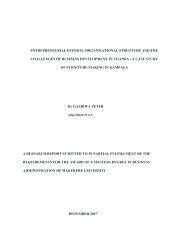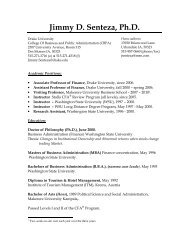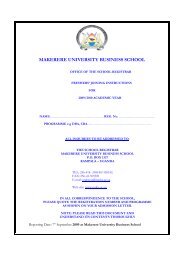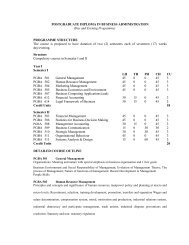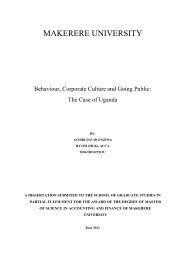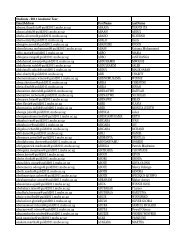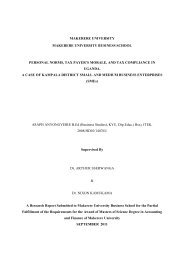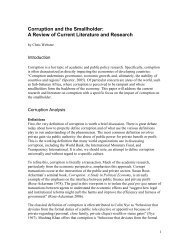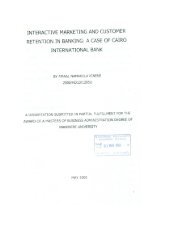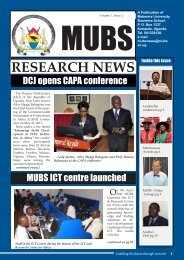13th Annual International Management Conference Proceeding
13th Annual International Management Conference Proceeding
13th Annual International Management Conference Proceeding
You also want an ePaper? Increase the reach of your titles
YUMPU automatically turns print PDFs into web optimized ePapers that Google loves.
this study, land was measured in physical units of hectares, although the method did not allow an expression<br />
of land quality differences across farms.<br />
Capital use measurement<br />
It is very difficult to measure and identify capital as indicated by Heady et al. (1969). The historical<br />
tendency has been to reduce capital input categories and measure input of durable assets by actual<br />
maintenance and depreciation costs associated with their use, rather than by their capital value on inventory<br />
basis. Similarly, in this study only actual flow of services of farm equipment within the selected production<br />
period were considered. A summation of annual straight-line depreciation charges on all tools and<br />
implements that were directly involved in banana production represented an investment in capital. On the<br />
basis of this, a Cobb-Douglas production function was formulated as;<br />
Y=aLD b1 C b2 LB b3 M b4 e ui ………………………………………………………………(1)<br />
Where a = Constant<br />
Y = Banana output<br />
LD = Land<br />
C = Capital<br />
LB = Labour<br />
M = Manure use<br />
b1, b2---ui are coefficients of determination<br />
Manure application M was used as a dummy variable. M took the value of 0 if no and 1 if yes.<br />
Estimation procedure<br />
Banana production enterprise involves the use of inputs that include labour, land, and capital. These<br />
variables in combination at various levels impact on the level of banana output. The individual contributions<br />
of these variables to total yield can be established with a Cobb-Douglas type of production function<br />
specified as follows;<br />
Ymi=aLD b1 CP b2 LB b3 M b4 e ui …………………………………………………..……. (2)<br />
Where: Ymi = banana yield (bunches ha- 1), a = constant, CP = Capital, LD = Land, = Manure use, LB =<br />
labor, e = error term and bi = coefficients for the various inputs. Equation (2) is then expressed in natural<br />
logarithms leading to a function linear in the parameters except for the dummy variables.<br />
Ln Ym=lna+b1lnLB+b2lnCP+b3lnLD+b4lnM+Ui………………………………….(3)<br />
Estimation of the function with transformed elasticities leads to straight measurement of elasticities. In<br />
equation (3), coefficients bi s then give an estimate of returns to scale associated with banana production<br />
process in rural Uganda. When the sum is greater than one, there are increasing returns, less than one<br />
indicates decreasing returns, and one shows constant returns to scale. Elasticity of coefficients are similarly<br />
derived using mathematical calculus principles. The coefficients in Equation (3) represent elasticities of<br />
production with respect to the various inputs. As proved from mathematical calculus procedures by taking<br />
the first derivatives of the model, it follows then that:<br />
�Yi<br />
�<br />
� bi<br />
ax x<br />
�X<br />
i<br />
je<br />
bi<br />
1 b ui<br />
i j<br />
.......... .......... .......... .......... .......... .......... .......... .......... .........( 4)<br />
Where xj, xi = vector of inputs, j≠i, Yi = banana output (bunches ha -1 ) with the assumption that the Cobb-<br />
Douglas production function assumes constant elasticity (Ep) of production over the entire input-output<br />
curve then.<br />
�y<br />
�x<br />
1<br />
1<br />
x<br />
*<br />
y<br />
1<br />
1<br />
�y<br />
�<br />
�x<br />
2<br />
2<br />
x<br />
*<br />
y<br />
2<br />
2<br />
�y<br />
� .......... ... �<br />
�x<br />
n<br />
n<br />
x<br />
*<br />
y<br />
Therefore the elasticity of production (Ep) is given by;<br />
75<br />
n<br />
n<br />
.......... .......... .......... .......... .......... .......... ...( 5)



